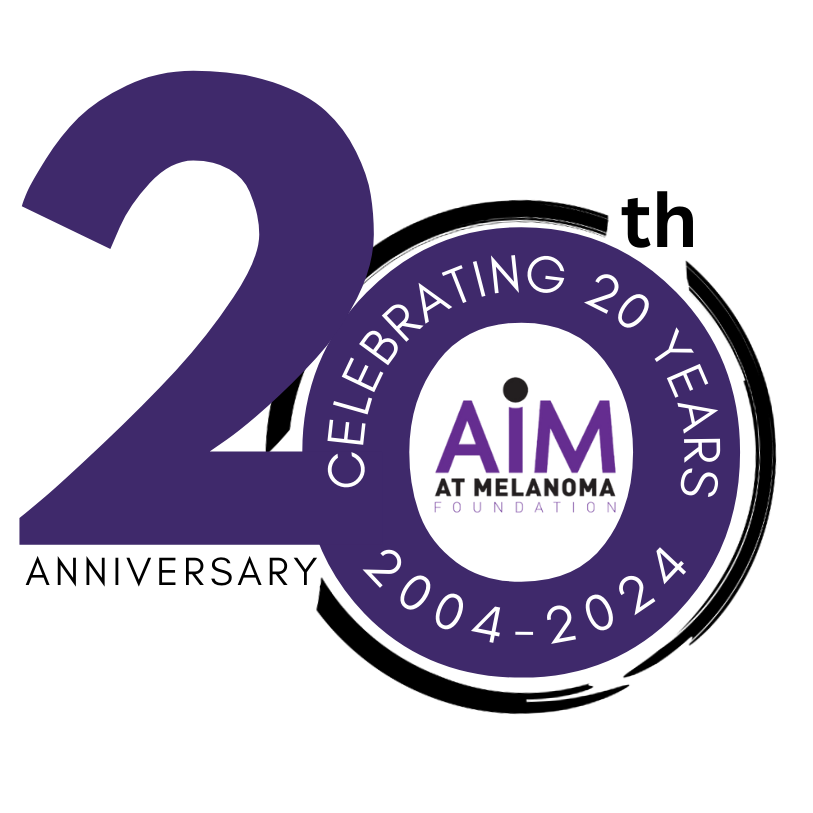AIM at Melanoma Celebrating 20 Year Anniversary

Twenty years ago, the AIM at Melanoma Foundation was established by a determined woman with a relentless drive to find the cure for melanoma while improving the lives of those it affects.
Recognizing the urgent need for research after losing her 26-year-old daughter, Charlie Guild, to melanoma, Valerie Guild, the late founder of AIM at Melanoma, took it upon herself to make a difference. With dedication and passion, Val established an organization that would become a beacon of hope for patients with melanoma, and their families, caregivers, and friends.
 For the past two decades, this organization has been unwaveringly committed to finding a cure for melanoma as part of its mission. One of the significant contributions made by AIM at Melanoma is the establishment of the International Melanoma Tissue Bank Consortium (IMTBC). This consortium consists of multiple sites and researchers who collect fresh frozen primary melanoma tissues, which have been hailed as the “holy grail of resources” for researchers. These tissues provide invaluable insights into the nature and progression of melanoma, with the goal of finding more effective treatments and, ultimately, the cure for melanoma. To date, the IMTBC has amassed nearly 200 melanoma tissues, along with the corresponding patient data (anonymized) and blood samples—an extremely valuable combination of information for researchers. AIM at Melanoma will soon open this vast collection beyond the consortium to leading scientists and medical institutions worldwide.
For the past two decades, this organization has been unwaveringly committed to finding a cure for melanoma as part of its mission. One of the significant contributions made by AIM at Melanoma is the establishment of the International Melanoma Tissue Bank Consortium (IMTBC). This consortium consists of multiple sites and researchers who collect fresh frozen primary melanoma tissues, which have been hailed as the “holy grail of resources” for researchers. These tissues provide invaluable insights into the nature and progression of melanoma, with the goal of finding more effective treatments and, ultimately, the cure for melanoma. To date, the IMTBC has amassed nearly 200 melanoma tissues, along with the corresponding patient data (anonymized) and blood samples—an extremely valuable combination of information for researchers. AIM at Melanoma will soon open this vast collection beyond the consortium to leading scientists and medical institutions worldwide.
In addition to the IMTBC, in 2008, AIM at Melanoma established the world’s leading think tank for melanoma, called the International Melanoma Working Group (IMWG), comprising 25 of the world’s leading melanoma researchers who gather twice yearly and are joined by select industry partners to communicate about and collaborate on their work. By facilitating research partnerships and resources on such an international scale, AIM at Melanoma is driving scientific advancements that will ultimately help end melanoma.
In addition to our scientific contributions, AIM at Melanoma has provided crucial support to people affected by this devastating disease. Our website is the most comprehensive source of information on melanoma available to the general public. We offer symposiums, webinars, podcasts, and other educational opportunities on a nearly weekly basis throughout the year. We run a peer mentoring program that connects survivors with newly diagnosed patients, as well as an Ask a Medical Expert service, which allows the community to ask questions of a highly experienced melanoma physician assistant.
The final piece of AIM’s mission is to advocate for patients and their families. This work is critical, and AIM leads the melanoma community in this area. AIM has been at the forefront of indoor tanning and oral parity legislation over the years, and we are tapped as the patient advocate—often the lone patient advocate—on numerous boards and committees for physicians, government, and industry partners.
AIM at Melanoma’s advocacy extends beyond national boundaries. We organize and fund a network of international patient advocates who exchange knowledge, share best practices, and improve global outcomes in the fight against melanoma. And we bring together these patient advocates with researchers and industry partners in their countries to advance all of their work.
The year 2004 marked a turning point in the fight against melanoma. Through one woman’s unwavering commitment to finding a cure after the loss of her daughter, AIM at Melanoma has made remarkable progress in advancing research efforts and improving patient outcomes in the fight against melanoma. While there is still much work to be done, there is cause for celebration in this 20th year, as AIM at Melanoma continues to inspire hope and bring us closer to a future without this deadly disease.
About AIM
AIM at Melanoma is proud of its impact over the last 20 years. From its modest roots operating out of the living room of its founder, Valerie Guild, after she lost her 26 year old daughter to melanoma, AIM has grown to be a global foundation whose work focuses on three critical areas: innovative and collaborative research; legislation, policy, and advocacy; and education. AIM at Melanoma’s foundation principles include the understanding that melanoma is a global disease, and to both prevent the disease and identify successful therapies, we must work globally and collaboratively. AIM is based in the United States, but we work with researchers, advocates, policy makers, and patients around the world.
AIM’s global research initiatives include The International Melanoma Tissue Bank Consortium, The Melanoma International Collaboration for Adaptive Trials, and The International Melanoma Working Group. AIM at Melanoma provides education, connection to resources and opportunities for meaningful engagement to help patients and caregivers/families better face the challenges of melanoma. Founded in 2004, AIM at Melanoma is dedicated to finding more effective treatments and, ultimately, the cure for melanoma while improving the lives of those it affects. For more information, visit www.AIMatMelanoma.org and follow our groundbreaking initiatives on Facebook, Twitter, and YouTube.
About Melanoma
Melanoma is one of the fastest-growing cancers in the United States and worldwide. It’s one of the most complex forms of cancer and has the most mutations of all solid cancers. In the U.S., melanoma is the third most common cancer among men and women ages 20-39 and the fifth most common cancer in both men and women of all age groups. Incidence rates are higher in women than in men before the age of 50, but by age 65, rates in men double those in women, and by age 80, they are triple.
Recent Posts

Behavioral Addiction Responsible for Excessive Indoor Tanning

Announcing AIM at Melanoma’s Official Sunscreen Partner, WearSPF

Red Hair Genetics: 5 Things You May Not Know

Surviving & Thriving: From Melanoma Survivor to Sun Safety Advocate


